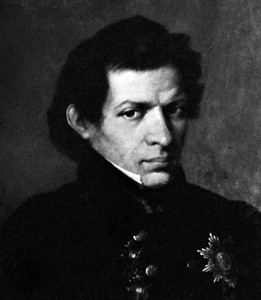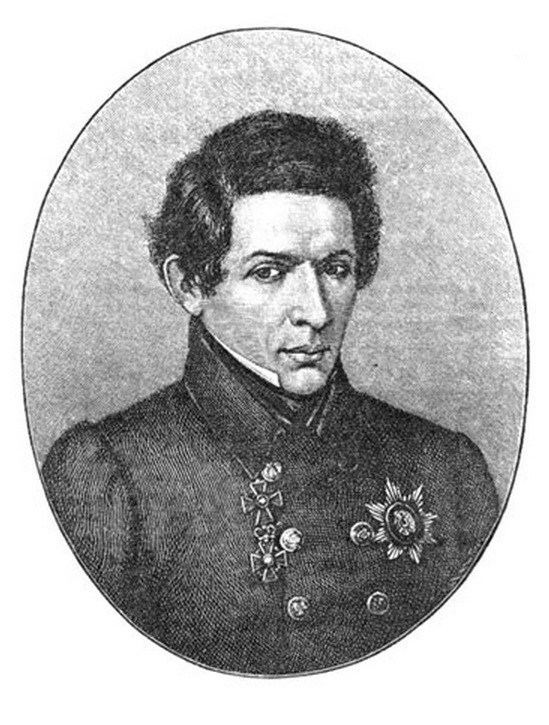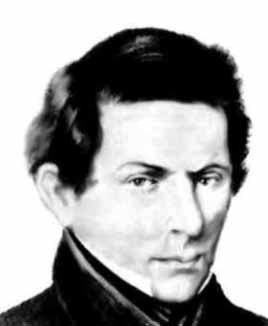Nationality Russian Name Nikolai Lobachevsky Role Mathematician | ||
 | ||
Books Pangeometry, Geometrical researches on the theory of parallels Parents Ivan Maksimovich Lobachevsky, Praskovia Alexandrovna Lobachevskaya Similar People Bernhard Riemann, Lucio Lombardo‑Radice, Nikolai Brashman, Leonhard Euler, William Kingdon Clifford | ||
Doctoral students Nikolai Brashman Academic advisors J. C. M. Bartels | ||
Nikolai Lobachevsky
Nikolai Ivanovich Lobachevsky (Russian: Никола́й Ива́нович Лобаче́вский; [nʲikɐˈlaj ɪˈvanəvʲɪtɕ ləbɐˈtɕɛfskʲɪj]; 1 December [O.S. 20 November] 1792 – 24 February [O.S. 12 February] 1856) was a Russian mathematician and geometer, known primarily for his work on hyperbolic geometry, otherwise known as Lobachevskian geometry.
Contents
- Nikolai Lobachevsky
- NIKOLAI LOBACHEVSKY BLOQUE A 2013
- Life
- Career
- Impact
- Honors
- In popular culture
- Works
- References

William Kingdon Clifford called Lobachevsky the "Copernicus of Geometry" due to the revolutionary character of his work.

NIKOLAI LOBACHEVSKY BLOQUE A 2013
Life

Nikolai Lobachevsky was born either in or near the city of Nizhny Novgorod in the Russian Empire (now in Nizhny Novgorod Oblast, Russia) in 1792 to parents of Polish origin – Ivan Maksimovich Lobachevsky and Praskovia Alexandrovna Lobachevskaya. He was one of three children. His father, a clerk in a land surveying office, died when he was seven, and his mother moved to Kazan. Lobachevsky attended Kazan Gymnasium from 1802, graduating in 1807 and then received a scholarship to Kazan University, which was founded just three years earlier in 1804.

At Kazan University, Lobachevsky was influenced by professor Johann Christian Martin Bartels, a former teacher and friend of German mathematician Carl Friedrich Gauss. Lobachevsky received a master's degree in physics and mathematics in 1811. In 1814, he became a lecturer at Kazan University, in 1816 he was promoted to associate professor, and in 1822, at the age of 30, he became a full professor, teaching mathematics, physics, and astronomy. He served in many administrative positions and became the rector of Kazan University in 1827. In 1832, he married Varvara Alexeyevna Moiseyeva. They had a large number of children (eighteen according to his son's memoirs, while only seven apparently survived into adulthood). He was dismissed from the university in 1846, ostensibly due to his deteriorating health: by the early 1850s, he was nearly blind and unable to walk. He died in poverty in 1856.

He was an atheist.
Career
Lobachevsky's main achievement is the development (independently from János Bolyai) of a non-Euclidean geometry, also referred to as Lobachevskian geometry. Before him, mathematicians were trying to deduce Euclid's fifth postulate from other axioms. Euclid's fifth is a rule in Euclidean geometry which states (in John Playfair's reformulation) that for any given line and point not on the line, there is one parallel line through the point not intersecting the line. Lobachevsky would instead develop a geometry in which the fifth postulate was not true. This idea was first reported on February 23 (Feb. 11, O.S.), 1826 to the session of the department of physics and mathematics, and this research was printed in the UMA (Вестник Казанского университета) in 1829–1830. Lobachevsky wrote a paper about it called A concise outline of the foundations of geometry that was published by the Kazan Messenger but was rejected when it was submitted to the St. Petersburg Academy of Sciences for publication.
The non-Euclidean geometry that Lobachevsky developed is referred to as hyperbolic geometry. Lobachevsky replaced Playfair's axiom with the statement that for any given point there exists more than one line that can be extended through that point and run parallel to another line of which that point is not part. He developed the angle of parallelism which depends on the distance the point is off the given line. In hyperbolic geometry the sum of angles in a hyperbolic triangle must be less than 180 degrees. Non-Euclidean geometry stimulated the development of differential geometry which has many applications. Hyperbolic geometry is frequently referred to as "Lobachevskian geometry" or "Bolyai–Lobachevskian geometry".
Some mathematicians and historians have wrongfully claimed that Lobachevsky in his studies in non-Euclidean geometry was influenced by Gauss, which is untrue. Gauss himself appreciated Lobachevsky's published works very highly, but they never had personal correspondence between them prior to the publication. Although three people—Gauss, Lobachevsky and Bolyai—can be credited with discovery of hyperbolic geometry, Gauss never published his ideas, and Lobachevsky was the first to present his views to the world mathematical community.
Lobachevsky's magnum opus Geometriya was completed in 1823, but was not published in its exact original form until 1909, long after he had died. Lobachevsky was also the author of New Foundations of Geometry (1835–1838). He also wrote Geometrical Investigations on the Theory of Parallels (1840) and Pangeometry (1855).
Another of Lobachevsky's achievements was developing a method for the approximation of the roots of algebraic equations. This method is now known as the Dandelin–Gräffe method, named after two other mathematicians who discovered it independently. In Russia, it is called the Lobachevsky method. Lobachevsky gave the definition of a function as a correspondence between two sets of real numbers (Peter Gustav Lejeune Dirichlet gave the same definition independently soon after Lobachevsky).
Impact
E. T. Bell wrote about Lobachevsky's influence on the following development of mathematics in his 1937 book Men of Mathematics:
The boldness of his challenge and its successful outcome have inspired mathematicians and scientists in general to challenge other 'axioms' or accepted 'truths', for example the 'law' of causality which, for centuries, have seemed as necessary to straight thinking as Euclid's postulate appeared until Lobachevsky discarded it. The full impact of the Lobachevskian method of challenging axioms has probably yet to be felt. It is no exaggeration to call Lobachevsky the Copernicus of Geometry, for geometry is only a part of the vaster domain which he renovated; it might even be just to designate him as a Copernicus of all thought.
